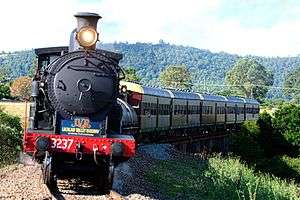New South Wales C32 class locomotive
|
Class C32 'P6' Class Locomotive | |||||||||||||||||||||||||||||||||
| |||||||||||||||||||||||||||||||||
| |||||||||||||||||||||||||||||||||
| |||||||||||||||||||||||||||||||||
| |||||||||||||||||||||||||||||||||
The C32 class was a class of steam locomotives built for the New South Wales Government Railways of Australia.
History
Introduction
When the new Chief Commissioner, Edward Eddy, took office in 1888, he was anxious to have additional locomotives manufactured within the Colony, and the Government sought the formation of a manufacturing company in New South Wales by interested parties. When this failed, designs were prepared prior to inviting tenders in England.[1]
Beyer, Peacock and Company was selected to build the new locomotives. The first batch of 50 locomotives were delivered between February 1892 and July 1893. They became known as the Manchester Engines.[1]
At the request of the Railway Commissioners, the builders altered the last two engines of the first batch to operate as compounds, but these did not prove satisfactory and during 1901 were converted to 2-cylinders. The particular compound arrangement was never used in another locomotive, before or since.[1]
Further orders over the 19 years saw 11 locomotives built the last being delivered in April 1911. The initial 50 were built with six wheel tenders, the remainder with eight wheel bogie tenders. Many of the originals were later equipped with bogie tenders, however a number of the class kept the shorter tenders to enable them to be turned on the 50-foot (15.24 m) turntables at certain locations, including Hornsby, Campbelltown and Maitland.[1] Hornsby had a 60' turntable in the 1960s. When was it 50'?
The final engine was built with a superheater, and tests showed a significant improvement in performance; as result the remaining 190 engines were similarly fitted as they became due for boiler renewal between 1914 and 1939.[1][2]
The first passenger locomotives used on the Trans-Australian Railway the 26 strong Commonwealth Railways G class, were of similar design, and the class leader is preserved at the National Railway Museum, Port Adelaide.[3]
Into service
When first introduced, the class was assigned to the Northern and Southern mail and express trains. Following the strengthening of the Wagga Wagga Viaduct in 1901, they worked the full length of the Main South line from Sydney to Albury, the express covering the 621 km in 12 hours and 35 minutes, including 14 stops.[1]
With the arrival of even larger engines from 1909 to handle the important mail and express trains, the P class were redeployed to other passenger services. In November 1929 they were used on the inaugural Newcastle Flyers.[4] They also began hauling the Caves Express to Mount Victoria and the South Coast Daylight Express to Bomaderry.[1]
Apart from some very light country branch lines, the class worked throughout the state. They worked almost all South Coast line passenger services right up until the end of steam. They were equally at home on commuter services to Campbelltown or Richmond; on Newcastle suburban trains as far as Singleton and Dungog; on country branch line mixed or goods trains or even the Riverina Express from Narrandera to Griffith.[1]
Last years & demise
The first of the class to be withdrawn was 3264 following an accident at Otford in July 1956. Following the arrival of the 48 class diesels from 1959 withdrawals began in earnest. On 24 July 1971 the last regularly steam-hauled passenger train in New South Wales was hauled by 3246 from Newcastle to Singleton. In December 1971 3229 (a shunting locomotive at Goulburn Depot) was the last of its class to be withdrawn.[1][2]
The member of the class which attained the highest distance travelled in its life was 3210, with a figure of 4,185,685 kilometres (2,600,864 mi) which was also the highest distance travelled by any New South Wales steam locomotive.[1]
Preservation
| Preserved C32 Class Locomotives | ||||||||
|---|---|---|---|---|---|---|---|---|
| No. | Description | Manufacturer | Year | Current Organisation | Location | Status | Ref | |
| 3203 | 4-6-0 passenger | Beyer, Peacock and Company | 1891 | NSW Rail Transport Museum | Broadmeadow Locomotive Depot | stored | NSW Locomotive, Steam 3203 | |
| 3214 | 4-6-0 passenger | Beyer, Peacock and Company | 1891 | NSW Rail Transport Museum | Valley Heights | cosmetic restoration | ||
| 3237 | 4-6-0 passenger | Beyer, Peacock and Company | 1892 | Lachlan Valley Railway | Eveleigh Workshops | operational | ||
| 3265 | 4-6-0 passenger | Beyer, Peacock and Company | 1901 | Powerhouse Museum | Thirlmere | operational | PHM Locomotive 3265 | |
Gallery
 Locomotive 3237 at Taree Railway Centenary 2013
Locomotive 3237 at Taree Railway Centenary 2013 3203 in storage at Broadmeadow No.2 Roundhouse
3203 in storage at Broadmeadow No.2 Roundhouse

 3224 at Rockdale
3224 at Rockdale- 3237 at the Hunter Valley Steamfest 2009
- 3265 at Sydney Central in 2009
- 3214 on static display at the New South Wales Rail Transport Museum, Thirlmere
See also
References
| Wikimedia Commons has media related to New South Wales C32 class locomotives. |
- 1 2 3 4 5 6 7 8 9 10 Grunbach, Alex (1989). A Compendium of New South Wales Steam Locomotives. Sydney: Australian Railway Historical Society, NSW Division. pp. 115–127. ISBN 0 909650 27 6.
- 1 2 Oberg, Leon (1984). Locomotives of Australia 1850s - 1980s. Frenchs Forest: Reed Books. pp. 69–70. ISBN 0 730100 05 7.
- ↑ Oberg, Leon (1984). Locomotives of Australia 1850s - 1980s. Frenchs Forest: Reed Books. p. 122. ISBN 0 730100 05 7.
- ↑ Flyer. Sydney: New South Wales Rail Transport Museum. 1970. pp. 1, 2, 4. ISBN 0-909862-16-8.
